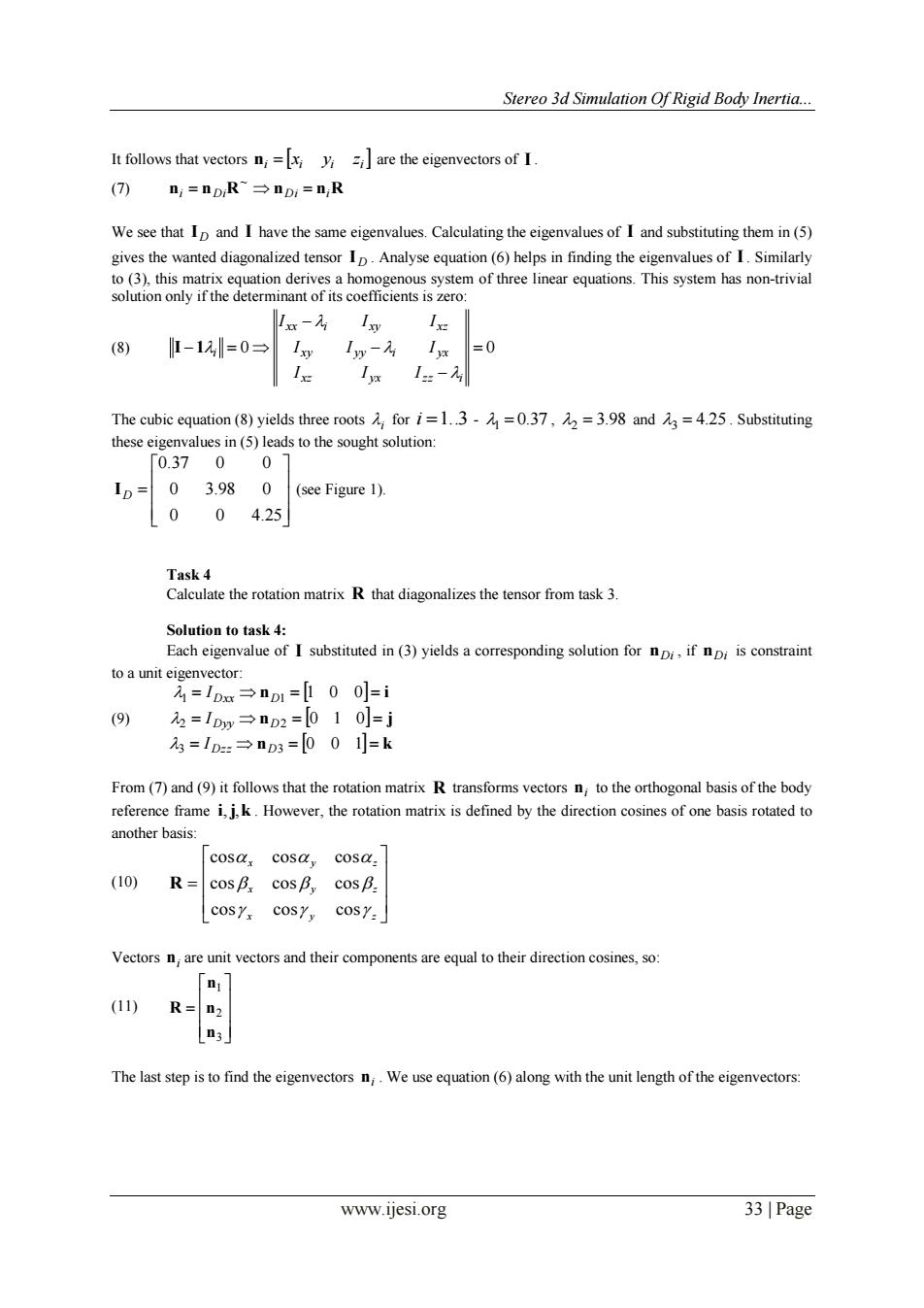正在加载图片...

Stereo 3d Simulation Of Rigid Body Inertia... It follows that vectorsn=y are the eigenvectors of I (7) n;=nDR→nDi=n,R We see that Ip and I have the same eigenvalues.Calculating the eigenvalues of I and substituting them in(5) gives the wanted diagonalized tensor Ip.Analyse equation(6)helps in finding the eigenvalues of I.Similarly to (3),this matrix equation derives a homogenous system of three linear equations.This system has non-trivial solution only if the determinant of its coefficients is zero: - 1对 1 (8) -1=0→ 1w- =0 1 1x1=- The cubic equation(8)yields three roots for i=1..3-=0.37,=3.98 and=4.25.Substituting these eigenvalues in(5)leads to the sought solution: 「0.370 0 ID= 0 3.98 0 (see Figure 1). 0 04.25 Task 4 Calculate the rotation matrix R that diagonalizes the tensor from task 3. Solution to task 4: Each eigenvalue of I substituted in(3)yields a corresponding solution for npi,if npi is constraint to a unit eigenvector: =1Dx→np1=00]=i (9) 2=1D→np2=[010]=j 3=1D=→nD3=[001]=k From(7)and (9)it follows that the rotation matrix R transforms vectors n;to the orthogonal basis of the body reference frame i,j,k.However,the rotation matrix is defined by the direction cosines of one basis rotated to another basis: cosa cosay cosa. (10) R= cosB. cosB cos B. cosy cosy, Vectors n;are unit vectors and their components are equal to their direction cosines,so: 1 (11) R= n2 n3 The last step is to find the eigenvectors n;.We use equation(6)along with the unit length of the eigenvectors: www.ijesi.org 33|PageStereo 3d Simulation Of Rigid Body Inertia... www.ijesi.org 33 | Page It follows that vectors i i i i n x y z are the eigenvectors of I. (7) ni nDiR nDi niR ~ We see that ID and I have the same eigenvalues. Calculating the eigenvalues of I and substituting them in (5) gives the wanted diagonalized tensor ID . Analyse equation (6) helps in finding the eigenvalues of I. Similarly to (3), this matrix equation derives a homogenous system of three linear equations. This system has non-trivial solution only if the determinant of its coefficients is zero: (8) 0 0 xz yx z z i xy yy i yx xx i xy xz i I I I I I I I I I I 1 The cubic equation (8) yields three roots i for i 1..3 - 1 0.37 , 2 3.98 and 3 4.25 . Substituting these eigenvalues in (5) leads to the sought solution: 0 0 4.25 0 3.98 0 0.37 0 0 ID (see Figure 1). Task 4 Calculate the rotation matrix R that diagonalizes the tensor from task 3. Solution to task 4: Each eigenvalue of I substituted in (3) yields a corresponding solution for nDi , if nDi is constraint to a unit eigenvector: (9) n k n j n i 0 0 1 0 1 0 1 0 0 3 3 2 2 1 1 Dzz D Dyy D Dxx D I I I From (7) and (9) it follows that the rotation matrix R transforms vectors ni to the orthogonal basis of the body reference frame i,j,k . However, the rotation matrix is defined by the direction cosines of one basis rotated to another basis: (10) x y z x y z x y z cos cos cos cos cos cos cos cos cos R Vectors ni are unit vectors and their components are equal to their direction cosines, so: (11) 3 2 1 n n n R The last step is to find the eigenvectors ni . We use equation (6) along with the unit length of the eigenvectors: